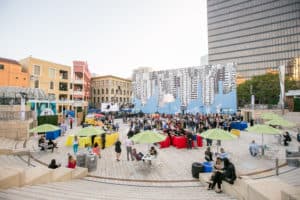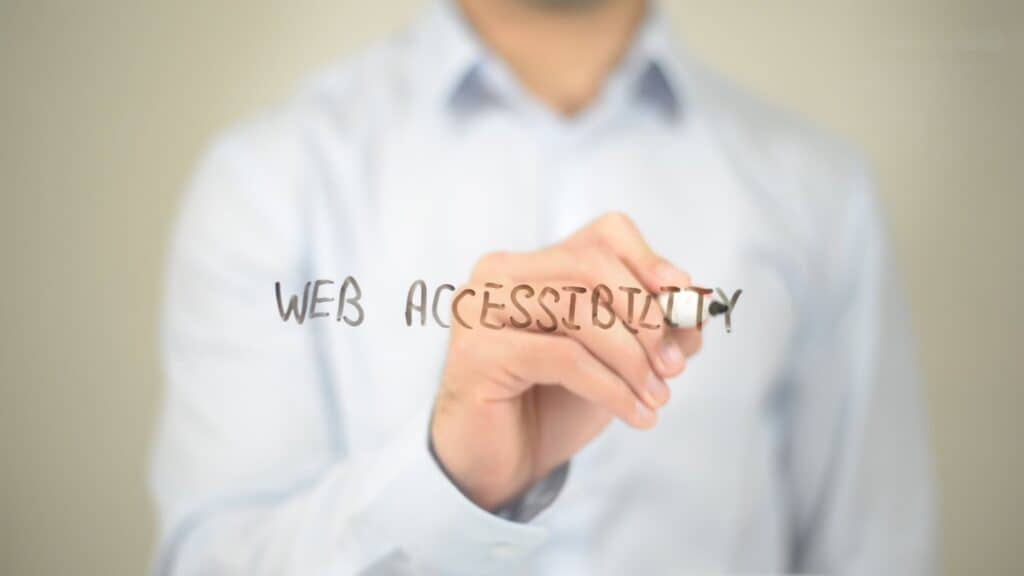Planning an event often involves many moving pieces, hidden costs, and unforeseen obstacles. Unfortunately, more often than not, accessibility at events is an afterthought rather than a priority. At Vario, we’re here to help you prioritize accessibility so you can have an inclusive event for all of your attendees.
We’ll define what accessibility at an event looks like and then walk you through a complete checklist for making your next event accessible to all.
What Does Accessibility at an Event Mean?
Accessibility means ensuring your event can be attended and enjoyed by anyone, regardless of physical, mental, or alternate restrictions. To ensure the best experience possible, there needs to be a defined strategy built into your event plan to provide the best experience for all attendees. To set this strategy in motion, send out a pre-event survey to make sure you understand all needed accommodations. Then, choose an event venue that is able to fulfill those needs.
Planning an accessible event goes beyond meeting the mandatory ADA requirements. It begins with a mindset that is geared toward inclusion. Subsequently, the more inclusive you can be, the more people can attend your event.
If you are looking for a guide to planning your event and want to ensure it is inclusive, use the checklist below to satisfy and engage your attendees.
How to Make your Event more Accessible: A Checklist
As mentioned above, accessibility is often hindered by a lack of a strategy or simply not having a plan in place. Fortunately, by taking the time to have a better understanding of how to make your event more accessible, and with the assistance of a seasoned team like Vario, these obstacles to accessibility can be avoided.
So, how do you make an event accessible? Accessibility can be broken down into three main ideas: open channels of communication, overcoming limitations, and seamless integration.
Open Channels of Communication
The best way to kickstart your planning is by sending a pre-event survey to gauge what kind of event accommodations your guests will need. Allow your attendees to tell you if they require any special assistance or accommodation requests. In your pre-event survey, you can include open-ended questions asking for a list of specific accommodations, or you can use our checklist below, as a guide.

Additionally, the website or platform you are using should include options for the visually or hearing impaired, in both desktop and mobile-friendly versions. To express your commitment to inclusion, add an accessibility statement on your website to make it clear that you are providing accessible measures.
Below is a great example of what a statement should look like in the footer or on your about us page.
“At Vario, we are passionate about providing a website that is accessible to everyone, regardless of their disability. Our goal is to uphold a standard that the accessibility community deserves at every event. Additionally, our web design practices follow ___ guidelines to create an experience that is digitally accessible.”
You can also provide a simpler statement, such as “This event is wheelchair accessible and priority seating is provided” or “This event will provide interpreting services.”
Open channels of communication allow your attendees to feel comfortable and supported before the event even begins. It also helps your team understand the measures needed so the event can be as seamless as possible. After the event, consider a post-event survey that specifically asks for feedback on the accessibility accommodations so that you can improve your strategy for your next event.
Overcoming Limitations
Overcoming limitations includes things like holding your event at an ADA-compliant building, or providing an extra 20-30 minutes in between activities so that attendees with mobility restrictions have ample time to get to the next activity. Overcoming this limitation includes figuring out how much money should be allocated to meet accessibility guidelines. Choosing an ADA-compliant building or venue that accommodates all guest needs while staying within your event planning budget is essential. It may take looking at multiple venues to get a better feel for what will work best for your team and your attendees.
Additionally, you should be thinking about how many staff members need to be involved in providing additional assistance to attendees during the event, as well as attendees who may need more individualized assistance.
Seamless Integration
When considering which technology to use, keep in mind the ones that integrate well with other technologies. This way, when you are using an outside third-party platform it will make things easier when the information can easily integrate with your platform or website so you don’t have to duplicate efforts. This step involves researching what platforms work together in addition to testing the integration thoroughly up until your event begins. Fortunately, some virtual platforms have the capability of seamless integration so you can avoid the headache of trying to find one yourself. Our Virtual by Vario platform can provide real-time captioning driven by AI, ASL support services, PDF versions of recorded presentations, and more.
Overall, open channels of communication, overcoming limitations, and seamless integration all work together to create a solution-oriented mindset of inclusion. We are here to help you strategize and implement your event’s accommodations.
Now that you have a better understanding of how you can make your event more accessible, let’s walk through your event planning checklist:
#1 Consult ADA Specific Guidelines
First, your team should consult ADA Specific Guidelines. The ADA’s website is a great starting place for legal requirements regarding accessibility for Americans with Disabilities.
We dive into a bit more detail later in the article, but in the meantime here are some basic accessibility requirements that every event should plan for:
Handicap Accessible – A person with disabilities must be given equal access to any and all amenities that a non-disabled attendee can access. This includes Bathrooms, Walkways, Accessible Entrances/Exits, Accessible Seating, etc.
Elevator and Ramp Access – Those with mobility disabilities and who are using wheelchairs, scooters, or other mobility devices should be able to go wherever the activities of the day take them. While most buildings are ADA compliant, some older buildings (or even outdoor settings) tend to be less than accessible. Choosing a venue that has these accessibility features is vital to planning an event.
Parking and Transportation – Your live event should offer some kind of transportation assistance for those who cannot transport themselves. If your event location is in person, having accessible parking available is a pivotal aspect of ensuring your event is accessible for all.
Ample Time Between Event Activities – Even an event that provides maximum accessibility can still be tough to navigate. Everything from the foot traffic at the live event to lines for food and water can cause extra delays for those who need extra time to get around. This is an often overlooked aspect of planning an accessible event, and when considered can really boost user experience.
#2 Website Accessibility
For those who are visually or audibly impaired, navigating a website can be tough. Online tools that specialize in website accessibility, offering services and resources to help you make your website ADA compliant. Or, if you are looking for more support and guidance, we are happy to help make your website or web event ADA compliant.
Some important things that can make your website accessible include:
Adding alt text to images – Most CMS (Content Management System) platforms, such as WordPress, allow you to describe an image. With an alt text, visually impaired people can understand the image better. You can also use this function so the text will replace an image if it fails to load.
Enable resizable text – most browsers and mobile devices allow users to adjust the size of the text on your site. Test out the increasing font sizes so it doesn’t get too challenging to navigate.
Add keyboard navigation – those who are visually impaired will not be able to use a mouse to navigate your site. Make sure the major areas of your site can be navigated with a keyword only, such as the main pages, widgets, CTA’s, and more.
Incorporate videos & other multimedia – incorporating video is not only a great way to increase engagement on your site, but you can also add captions for deaf users and visually impaired users can listen.
Choose website colors wisely – people perceive color in different ways, particularly people who are color blind. Make sure that your background color is dark enough to adequately contrast the text on top, and vice versa.
When it comes to hybrid events, offering a virtual solution for those who can’t attend in person is a great way to keep your event accessible. This can be as easy as setting up a live stream of the event, break-out sessions, live Q&A sessions, and more.
#3 Wheelchair/Scooter Accessibility
Outdoor accessibility is commonly overlooked when planning an event. Those with mobility restrictions often find that there are more obstacles outside than inside. Unpaved areas like grass, dirt, or even seemingly unsuspecting surfaces like bumpy tile or cobblestone can pose safety threats to those with mobility restrictions. Consider all of these elements when planning your event so no one is left out.
While most indoor venues offer standard accessibility, it is always good to take a second look and ensure your venue is prioritizing accessibility instead of being an afterthought. For example, maybe your venue provides handicap accessibility, but through a freight elevator rather than the normal building elevator. In all instances, be sure to ask the building manager to specify how to access all of the ADA accessibility requirements properly.
#4 Light And Sound
We aren’t saying you can’t have an epic light show and a big sound system, but you need to share those details so your guests can be prepared. It is important that you over-communicate your event’s use of light and sound. There may be visually or audibly impaired or attendees who have medical conditions that make them sensitive to light and noise.
We recommend including as much information about the event as possible on your website or the event registration. It’s important to let your guests know if there will be any use of flash photography or strobe lights or images that may cause seizures. The same thing goes for sound. Let your attendees know if there will be amplified sounds or music and if you will provide assistive listening devices to accommodate attendees who are hard of hearing.
Additionally, let your keynote or guest speakers know there will be attendees with disabilities. This will allow the speaker to be more cognizant when speaking, such as talking steadily, pronouncing words clearly, and knowing where the visually or hard of hearing attendees are seated. Lastly, before the event, ask the speaker to submit their talking and visual materials so you can provide them to those who need them.
#5 Audio/Visual Accessibility
ASL and real-time live captions are the best methods for assisting the audio impaired as these methods most accurately convey the message from the speaker. You can choose a few different options for live captions, which include AI technology for automated captions, hiring an ASL interpreter, or hiring a team of real-time live captioning specialists.
Posting PDFs of your presentations in advance is another great way to keep the digital features of your event accessible. While speakers and presenters may not love the idea of sacrificing the element of surprise, the reality is that to make an event as accessible as possible; this is a great option for those who require extra time to digest content.
For the visually impaired, provide an audio version of written material or a braille alternative. If you are hosting an in-person, virtual, or hybrid event, there are plenty of audio options that can help those with low vision or eyesight impairments to enjoy it.
Trust Vario for Event Accessibility
Whether you’re planning an in-person, virtual, or hybrid event, accessibility should be a priority. To ensure your attendees are comfortable during the event, follow our accessibility checklist and check off all the steps.
The rigors of event planning can be frustrating, but this can be relieved with a strategic partner like us. Our supportive and experienced team not only has the practical insight to help you achieve your event goals, but we also implement a series of fail-safes to ensure that problems are solved before they ever happen.







